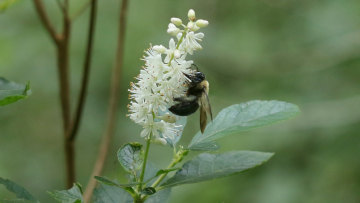Village News

PHOTO COURTESY OF GARRY KESSLER
Sweet pepperbush in bloom
August 27, 2021
NATURE NOTES
By Annie Reid
Westborough Community Land Trust
Sweet pepperbush rewards pollinators
In late July through early August, we find ourselves in an in-between time in summer, when blossoms are few and nectar is relatively scarce in the wild. Our pollinators – bees, butterflies, wasps, flies, and others – must struggle with a dearth of a nectar. One native plant that comes to the rescue is sweet pepperbush, a wild flowering shrub that begins to bloom at this time and continues through September.
Look for sweet pepperbush (Clethra alnifolia) in partial shade especially along streambanks, shorelines, or swamp edges. Perhaps you've seen it and wondered what it was. Festooned with spikes of small white blossoms, it offers a bonanza of nectar and an alluring aroma – the reason it's called "sweet." Its leaves are dark green and glossy.
Sweet pepperbush makes an attractive and efficient destination for nectaring insects. The flowers open progressively, starting at the bottom of a spike. This matches nicely with the habit of bees of crawling upward. Bees land on the flowers near the bottom of a spike and work their way up. Nectar is produced by specialized cells deep within the flowers.
The male and female parts of sweet pepperbush's blossoms emerge at different times, in a pattern that is efficient for cross-pollinating the plant. How does this work? You can think of each blossom as being "male" at first, when the male pollen-producing parts (10 anthers) emerge. Then think of each flower as later becoming "female" as the female pollen-receiving part (the stigma) emerges. As a result, the flowers near the bottom of a blossoming spike are oldest - and female. Those near the top of a spike are newest - and male. So what happens when a bee first lands, low on a spike? The older, female flowers pick up pollen that the bee is carrying from elsewhere. And then, as the bee climbs up the spike, the newer, male flowers dust the bee with new pollen before it flies off. That's efficient for both plant and bee.
Sweet pepperbush can create a wall of shrubbery, along a road, trail, or shore. It can grow 10 feet tall. Beside spreading by seed, it spreads by stolons (horizontal stems that grow on or just below the soil and sprout new plants), creating lots of nearby, genetically identical shrubs. This ability to spread in a couple of different ways helps sweet pepperbush to prosper. In a favorable environment, it can spread easily by stolons, using its current mix of genes. Its seeds also get transported to other areas with somewhat different conditions, where their new combinations of genes (from cross-pollination) may help new plants to do well.
If you're outside on a hot day and find yourself in place with sweet pepperbush, you're probably enjoying a pleasantly cool environment, relatively speaking, of course. Don't forget to watch for butterflies, bees, and other pollinators visiting the sweet pepperbush. In fall or winter, you might recognize the leafless shrub by the dry spikes and seed capsules that remain.
Sweet pepperbush can be a good choice for a partly shaded, damp area in a yard or in a native plant or pollinator garden.